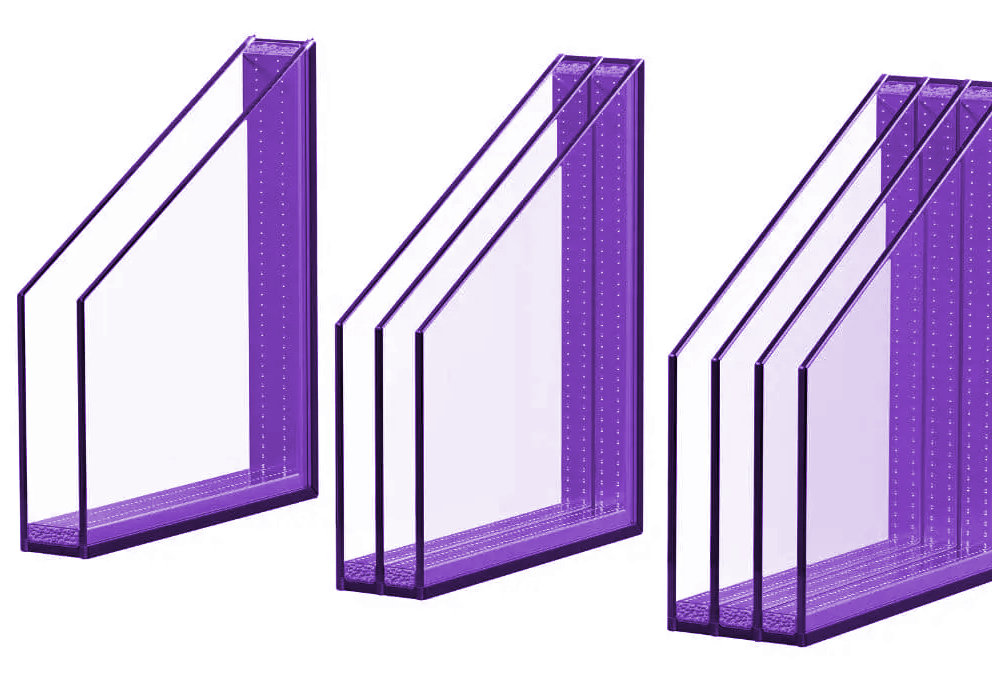
Double vs. Triple Glazing: A Financial Comparison Over 25 Years
When upgrading their home, homeowners often face a crucial decision regarding windows. Many will remember the rise of double-glazing windows in the 1990s and 2000s. Now, however, we are presented with a new option: double glazing or triple glazing? While triple glazing is widely considered a premium upgrade, it remains relatively uncommon. But is it worth the additional cost? Should more people be considering it? In this article, we compare the differences between double and triple glazing and conduct a financial assessment over a 25-year period to determine which option provides better value.
Double vs Triple Glazing? Key Differences You Should Know
Understanding U-Values: Why Triple Glazing Offers Better Insulation
The U-value measures the rate of heat transfer through a material: the lower the U-value, the better the insulation.
- Double glazing typically has a U-value of around 1.2 W/m²K.
- Triple glazing can achieve a U-value as low as 0.8 W/m²K.
This means that triple glazing loses significantly less heat compared to double glazing, resulting in better thermal efficiency. The U-value is an aggregate of both the frame and the glazing itself. While the glazing in triple-glazed windows has an improved U-value, the frame also plays a crucial role. In most cases, triple-glazed windows feature an improved U-value for both the frame and the glass.
Due to the lower U-value, triple glazing retains more heat inside a home, translating to lower energy bills, particularly in colder climates where heating costs are substantial.
Airtightness & Glazing: Why Triple Glazing Seals the Deal
Both double and triple glazing can provide excellent airtightness when properly installed. The level of airtightness depends more on the quality of installation and manufacture than the number of glazing panes. Air leakage typically occurs at the seals and joints of the window components, including opening casements, which must close with a firm and snug seal. High-end windows, whether double or triple glazed, tend to offer superior airtightness compared to budget alternatives. These frames often made from timber and more rigid than the PVC counterparts. Resulting in less flex and less air leakage.
Soundproofing Your Home
Peace and quiet is quickly becoming a luxary comodity. And triple glazing performs better at reducing external noise due to the additional layer of glass and insulating gas. The level of sound insulation is measured using the Rw (Weighted Sound Reduction Index):
- Double glazing typically provides sound insulation of 30-35 dB Rw.
- Triple glazing can offer 40-45 dB Rw.
For context:
- Normal indoor conversation: ~50-60 dB
- Busy street noise: ~70-80 dB
- Aircraft take-off (close range): ~120 dB
Since the decibel (dB) scale is logarithmic, an increase of 10 dB represents a tenfold increase in perceived loudness. This means that a sound at 30 dB is 10 times louder than a sound at 20 dB and 100 times louder than a sound at 10 dB. Because of this, triple glazing can make a significant difference in reducing noise pollution, particularly in busy urban areas or homes near major roads.
The Impact on Home Resale Value: Triple vs. Double Glazing
While both double and triple glazing add value to a property, triple glazing may offer a slight advantage in markets where energy efficiency and comfort are high priorities. However, the increase in property value alone is unlikely to justify the additional expense. Instead, we will quantify potential energy savings to assess its financial viability. Read an earlier blog on the impact of energy efficiency on house valuation in the UK to learn about the details.
Say Goodbye to Condensation: Why Triple Glazing Works Best
Triple glazing results in a more consistent internal temperature, reducing cold spots near windows. It also helps prevent condensation due to its superior insulation properties, leading to a healthier indoor environment. A crucial element to solving this predicament, is proper installation of the windows. By reducing the thermal bridging with proper tapes and foamed framed to wall connection points. Lastly installing the window both true and level is imperative.
Triple Glazing ROI: How Much Can You Save Over 25 Years?
In the following comparisons, we are only considering the cost of purchasing the windows, not the installation. For the purpose of simplification, we assume the installation costs are the same. We will compare the difference between good-quality PVC frames with Low Emissivity glass and a 20mm air cavity to high-end timber frame windows with 38mm triple glazing and gas-filled cavities.
Whilst the thermal performances in these examples are relatively accurate due to the use of PHPP (Passive House Planning Package), the costs are only estimates. In reality, every project is unique, and the variety of window types and sizes can significantly affect the price. The £310 per m2 figure used in these examples is an average from al the units on 1 project. Furthermore, the cost of a kilowatt has been assumed to be 10p. This, of course, can change considerably depending on the fuel type used, the use of a heat pump, or even the time of day. 10p have been used as a rough estimate for the cost of gas, or electricity with the use of a heat pump.
Property 1:
A 1930s detached property contains 2no. 2-bedroom flats.
- floor area of 116m2
- window surface area of 18.07m2
- Additional cost upgrading to triple glazed unit and timber frame = £ 310/ m2 meaning a total upgrade cost of £5,602
Using PHPP you can see a reduction in the heat loss through the glazing from 35 to 12 kW/m² yearly.


It is interesting to note that by just improving the window or the glazing the other building elements have shown a slight increase in heat loss. Highlighting the need to improve the thermal performance of the whole building envelope together. The heat finds the path of least resistance. Nevertheless, the overall heating demand have fall from 172 to 154 kWh/m2.
Importantly we will use this total reduction of 18kWh/m2 for the purpose of the financial calculation.
In this instance the property floor area is 135m2, the annual value of that energy saved is:
18kWh x 116m² x £0.10/kWh = £209
We can consider the value in two ways. Firstly, consider the net present value of each scenario given the 25 years of the solar panel’s life generating energy.
NPV=∑ Ct÷(1+r)t
Where:
- Ct is the cash inflow in year t (savings from solar energy).
- r is the discount rate. Typically used in financial prediction and considers such things as, risk, economic climate and desired return on investment. We could show results for (0%, 2% and 4%).
- t is the year number (from 0 to 25).
- The formula sums the discounted cash inflows for each year from year 1 to year 25.
NPV0 = £5,225
NPV2 = £4,080
NPV4 = £3,265
You can see here that depending on the discount rate used this figure surpasses the added cost to upgrade the windows. Meaning than you make your money back and gain the extra benefits for better windows.
Our second economic tool for comparison is Return On Investment (ROI) = Annual saving ÷ Initial Cost ×100. It is a great tool to compare to other investments.
ROI0 = £209 ÷ £5,602 ×100 = 3.7%
ROI2 = £163 ÷ £5,602 ×100 = 2.9%
ROI4 = £130 ÷ £5,602 ×100 = 2.3%
Ideally you can opt for an energy saving intervention that gives you the best ROI, but do not forget the non-financial benefits for the upgrades to be considered.
Property 2:
A Victorian terrace redesigned for the purpose of HMO
- floor area of 85.4m2
- window surface area of 18.45m2
- Additional cost upgrading to triple glazing = £ 310/ m2 meaning a total upgrade cost of £5,720.
Using PHPP you can see a reduction in the heat loss through the glazing from 50 to 17kW/m² yearly.


Despite a heat loss reduction through the windows there was a heating demand reduction of 25kW/m².
In this instance the property floor area is 85m2, the annual value of that energy saved is:
25kWh x 85m² x £0.10/kWh = £213
We can consider the value in two ways. Firstly, consider the net present value of each scenario given the 25 years of the solar panel’s life generating energy.
NPV=∑ Ct÷(1+r)t
NPV0 = £5,325
NPV2 = £4,159
NPV4 = £3,328
Our second economic tool for comparison is Return On Investment (ROI) = Annual saving ÷ Initial Cost ×100
ROI0 = £213 ÷ £5,720 ×100 = 3.7%
ROI2 = £166 ÷ £5,720 ×100 = 2.9%
ROI4 = £133 ÷ £5,720 ×100 = 2.3%
Property 3:
1980s three story town house
- floor area of 113m2
- window surface area of 23.8m2
- Additional cost upgrading to triple glazing =£310/ m2 meaning a total upgrade cost of £7,378.


Despite a heat loss reduction of 32/m² through the windows there was a heating demand reduction of 25kW/m².
In this instance the property floor area is 85m2, the annual value of that energy saved is:
25kWh x 113m² x £0.10/kWh = £283
We can consider the value in two ways. Firstly, consider the net present value of each scenario given the 25 years of the solar panel’s life generating energy.
NPV=∑ Ct÷(1+r)t
NPV0 = £7,075
NPV2 = £5,525
NPV4 = £4,421
Our second economic tool for comparison is Return On Investment (ROI) = Annual saving ÷ Initial Cost ×100
ROI0 = £283÷ £7,378×100 = 3.4%
ROI2 = £221 ÷ £7,378×100 = 3%
ROI4 = £127 ÷ £7,378×100 = 2.4%
Double or Triple Glazing? Let Resolve Do the Math for You
It is difficult to analyse the importance of the upgrade from double to triple glazing. In these examples, the ROI hovers around 3%, a good figure to bear in mind for investment-minded individuals. In general, it seems to take the entire lifespan of the windows to recover the initial cost. However, the value gained through airtightness, soundproofing, property valuation, and comfort cannot be quantified so easily.
These examples involve many variables, making them purely anecdotal. However, our experience working on these problems highlights some key points of interest.
The larger the window to heat loss area, the morse significance the windows roll plays in the heat loss strategy and the better return for the additional investment. Secondly the better the thermal performance of the other building element are the more significant the windows’ roll are is reducing heat loss. Remember that the heat always escapes unevenly through the building element of least resistance.
Consequently, a terrace property with large glazing in well preforming thermal envelope will see a better return on the glazing upgrade compared to a large detached poorly preforming building with less windows. The extra invest may be better employed in the upgrade of relatively cheaper methods of reduced heat loss.
We have also learnt that small changes in the window design make a significant difference in price. Fixed windows are considerably cheaper than openers. Casement windows are considerably cheaper than tilt and turn. And Sliding patio doors not only come at great expense compared to casement opening doors. But their performance often is significantly worse.
That being said, if budget constraints are not an issue which is rare, and you plan to stay in your home long-term, triple glazing is the better financial choice. Resolve sustainability can help you make informed decisions about which parts of your refurbishment should get the impetus of your effort to reduce energy consumption and lower your bills. Modelling your buildings predicted energy demand and using actually quotes, there is no reason to not be informed about the decisions you make. We give you the tools for considering both the energy savings and balancing initial costs with lifetime value.

